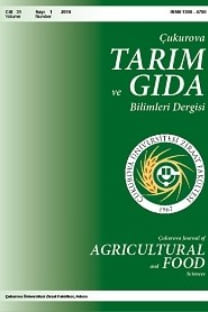Çukurova Bölgesinde Ekimde Çeşit Karışımının Upland Pamuğunun (Gossypium hirsutum L.) Verim ve Lif Kalitesine Etkisi
Tarla denemeleri farklı pamuk çeşit karışımlarının verim ve lif kalitesi üzerine etkisini araştırmak amacıyla yürütülmüştür. İki yıllık çalışmada üç ticari pamuk çeşidinin saf olarak ya da iki çeşidin farklı oranlarını içeren karışımlar halinde yetiştirilmesinin verim ve kalite özellikleri üzerine etkileri değerlendirilmiştir. Çeşitler, lif kalitesi üstün çeşitler yüksek verimli çeşit ile 0:100, 25:75, 50:50, 75: 25 ve 100:0 olmak üzere 5 değişik oranda, hacimce kombine edilmiştir. Karışık ekimler birçok yönden saf ekimlere oranla avantajlı olmuştur. Karışık ekimlerde kütlü pamuk verimi, lif verimi ve lif inceliği (mikroner) saf ekimlerdekine oranla daha yüksek olmuştur. Karışık ekimler lif uzunluğu, lif yeknesaklığı ve kısa lif içeriği yönünden saf ekimlerden farklı olmamakla birlikte, lif inceliği (mikroner) bazı karışık ekimlerde artmıştır. Çalışma bazı çeşit karışımlarının verimi önemli derecede arttırabileceğini göstermiştir. Rekabetle ilişkili olarak fizyolojik özelliklerin ve karışım performansının daha fazla araştırılması karışık ekimlerde yer alacak çeşitlerin en iyi kombinasyonun seçilmesinde yardımcı olacaktır
Anahtar Kelimeler:
Çeşit karışımları, Gossypium hirsutum L., lif kopma dayanıklılığı, mikroner, verim
Effect of Cultivar Blends on Yield and Fiber Quality of Upland Cotton (Gossypium hirsutum L.) in Planting in the Çukurova region, Turkey
Field trials were conducted to study the effect of blending different cotton cultivars on yield and fiber quality. Three commercial cotton cultivars grown alone and in blends containing different proportions of two cultivars were evaluated for yield and important fiber quality traits over a two years period. The cultivars were combined by volume, pairing the high fiber quality cultivars with high yielding cultivar in five different ratios, 0:100, 25:75, 50:50, 75:25, and 100:0. Blends had advantages over monocultures in several respects. The seed cotton yield, lint yield and micronaire in the blends were higher than in the pure cultivars. Blends did not differ significantly from components for fiber length, fiber length uniformity and short fiber index, but micronaire was higher in some blends than in the pure stands. The study showed that blending can increase yield significantly for some cultivar pairs. Further investigation of physiological traits in relation to competition and blend performance could help us to choose the best combination of varieties to include in blends
Keywords:
Cultivar blends, Gossypium hirsutum L., fiber strength, micronaire, yield,
___
- Bechere, E., Alexander , A., Auld, D.L., Downer, C.P. (2008). Effect of cultivar blends on fiber quality, lint yield, and gross return of Upland cotton in West Texas. Journal of Cotton Science 12:8– 15.
- Bridge, R.R., Miller, S.R., Lane, S.M. (1984). The influence of binary seed mixtures of ‘Stoneville 825’ and ‘Deltapine 41’ cotton cultivars on their performance. Bulletin # 931. Miss. Agric. For. Exp Stn., Mississippi State, MS, USA.
- Craig, C., Gwathmey, O. (2003). Variety blends for improved fiber quality in Tennessee. In: Proceedings of the Beltwide Cotton Conference, National Cotton Council America, Memphis, TN, USA, 6-10 January 2003; Nashville, TN, USA, pp.2556
- Deussen, H. (1989).Cotton fiber properties for high-speed spinning. In: Proceedings of the Beltwide Cotton Production Research Conferences. National Cotton Council, Memphis, TN, USA, pp. 104-106.
- Faircloth, J.C., Edmiston, K., Wells, R., Stewart, A. (2003). Planting cotton cultivar mixtures to enhance fiber quality. Journal of Cotton Science 7: 51- 56.
- McConnell, J.S., Bourland, F.M., Baker, W.H., Frizzell, B.S. (1997). Yield, earliness and fiber strength of blends of cotton (Gossypium hirsutum L.) cultivars. Arkansas Agricultural Experiment Station. Div. Agriculture University of Arkansas. April 1997 Bulletin 953.
- Meredith, W.R.Jr. (1991). Associations of maturity and perimeter with micronaire. In: Herber DJ, Richter DA, editors. Proceedings of the Beltwide Cotton Conferences, National Cotton Council of America, Memphis, TN, 8-12 January 1991; San Antonio, TX, USA, p. 569.
- Niles, G.A., Feaster, C.V. (1984). Breeding in “Cotton”. R.J. Kohel,C.F. Lewis (Eds.), American Society of Agronomy, Crop Science. Society of America, Soil Science Society of America. Madison, Wisconsin, USA, pp. 201-231.
- Özbek, N., Kaya, H., Dolançay, A., Borzan, G. Güvercin, R.Ş., Özkan, O.N., Karademir, E., Karademir, Ç. (2005). Türkiye Pamuk Lif Kalite Veri Tabanının Oluşturulması. http://www.nazillipamuk.gov.tr.
- Poehlman, J.M., Sleeper, D.A. (1995). Breeding field crops, (fourth edition), Iowa State University Press, Ames, Iowa. pp. 494.
- Riggs, T.J. (1970). Trials of cotton seed mixtures in Uganda. Cotton Growing Review 47: 100-111.
- ISSN: 2636-7874
- Başlangıç: 1973
- Yayıncı: Çukurova Üniversitesi
Sayıdaki Diğer Makaleler
Tohumluk Soya Üretiminde Hasat Öncesi Yağan Yağmurların, Tohum Kalitesi Üzerine Etkileri
Halis ARIOĞLU, Halil BAKAL, Leyla GÜLLÜOĞLU
Halis Arıoğlu, Süreyya Özyurtseven, Leyla Güllüoğlu
Etlik Piliç Kümeslerinin Serinletilmesinde Güneş Enerjisi Kullanımının Tekno-Ekonomik Analizi
